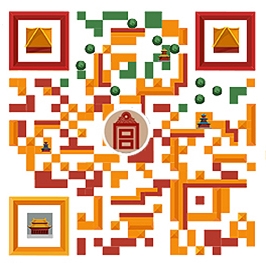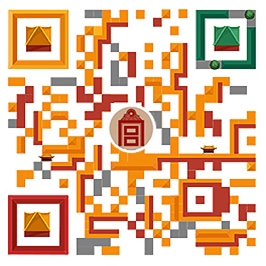國際博物館協(xié)會國際博物館培訓中心(ICOM-ITC)由故宮博物院與國際博協(xié)、國際博協(xié)中國國家委員會(中國博物館協(xié)會)于2013年7月合作建立,地點設(shè)在故宮博物院,為國際博協(xié)唯一博物館專業(yè)培訓機構(gòu)。
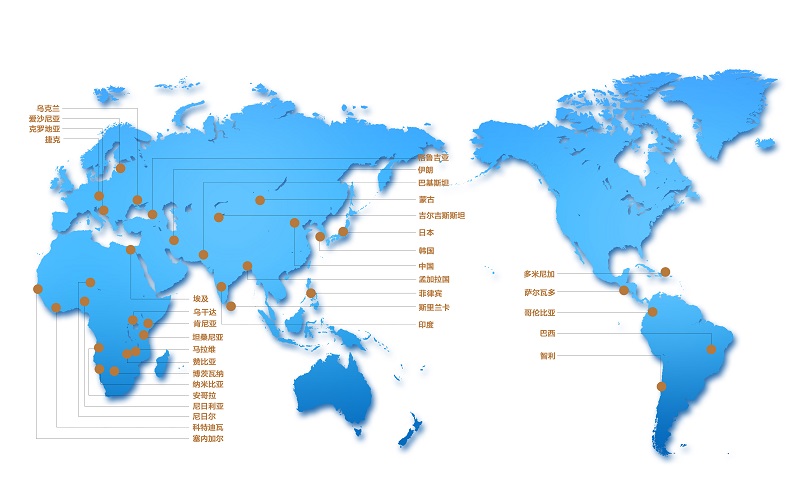
培訓中心每年舉辦春、秋兩期培訓。目前已成功舉辦八期北京常規(guī)培訓班和一期非洲特別培訓班,共有來自五大洲60個國家和國內(nèi)21個省份280名學員參與培訓,其中包括151名國際學員和129名中國學員。培訓班得到了來自世界各地博物館同仁的一致好評,不少學員培訓結(jié)束后都給培訓中心發(fā)來感謝信。
近期,培訓中心收到了來自第七期培訓班學員塞爾維亞“老村”露天博物館高級策展人Bojana Bogdanovic的反饋。她于2016年11月7日至11月15日來到北京參加國際博協(xié)培訓中心2016年秋季培訓班。培訓結(jié)束后,她將自己的所見所聞成文,并在塞爾維亞博協(xié)官方雜志公開發(fā)表。下文為部分節(jié)選內(nèi)容。
The ICOM International Centre for Museum Studies in Beijing is one of the most prestigious schools for museum experts in the world. Therefore, the opportunity to receive training at this institution is a great privilege. The ICOM Serbia representative was the first expert from our country to be awarded the grant for Beijing last year, at the same time being the only one from Europe among the colleagues from China and worldwide.
位于北京的國際博協(xié)培訓中心,是享譽全球博物館界的博物館專業(yè)人員學習圣地。能有機會在這里接受培訓對我來說真是莫大的榮幸。我是塞爾維亞博協(xié)派往北京參加這一培訓的第一人,也是參加去年秋季培訓班唯一的一位歐洲學員。

Words can hardly describe my surprise when I received an affirmative answer from the ICOM International Training Centre for Museum Studies that I had been chosen as one of the thirty participants in the training workshop Collecting Objects, Telling Stories, that took place in Beijing in the period 7?15 November. Along with the programme material, the organizer also attached the information about other participants. Looking at the pictures of Antonio from Mexico, Zahra from Iran, Virginia from Argentina, Marlie from China, Thai from Vietnam and other colleagues with whom I was going to spend seven days in faraway China, I could not even suppose how many precious things I was going to learn and how many new, long-standing connections I was going to make with colleagues from all over the world.
當我收到國際博協(xié)培訓中心錄取我為學員的確認信時,我的驚喜難以言表。11月7日至15日,我將和其他二十九名同學一起參加在北京舉辦的國際博協(xié)培訓中心2016年秋季培訓班。本期培訓的主題為“藏品與故事講述”。除了培訓日程等相關(guān)材料,組織者還在預先發(fā)來的培訓班相關(guān)資料中附上了其他學員的信息。我看到了同學的照片,他們是來自墨西哥的安東尼奧、伊朗的扎赫拉、阿根廷的弗吉尼婭、中國的王芳(Marlie)、越南的泰以及其他即將與我一起在遙遠的中國共度七天(編者注:培訓應為十天,這里是作者文中的一個錯誤,后文對該錯誤不再做更改和說明)的國際博物館同行。我禁不住想通過這次培訓我能學到多少寶貴知識,能與全世界的博物館界同行建立多么寶貴的專業(yè)聯(lián)系。
The Only European
唯一的歐洲人
The fact that, as a representative of ICOM Serbia and my own home museum ? “The Old Village” in Sirogojno, I was not only the only person from Serbia, but also the only European, was a huge responsibility for me and made me a little bit nervous when I started the trip. The journey to the Chinese capital took more than fifteen hours. Soon afterwards I officially met other participants. It was a chance for me to present the activities of the Open Air Museum “The Old Village” in Sirogojno, nominated for the best European museum award (EMYA) in 2014, and also to find out interesting information about the work of museums in Pakistan, Iran, Vietnam, Mongolia and the Philippines.
作為塞爾維亞博協(xié)及我所在博物館——斯若古捷諾鎮(zhèn)“老村”博物館派出的代表,我不僅是學員中唯一的塞爾維亞人,也是唯一的歐洲人。我深感肩上的重任,因而在啟程時有些許緊張。經(jīng)過了超過15小時的長途飛行,我終于抵達了中國的首都——北京。當日傍晚的小型見面會上,我正式認識了和我一起參加這次培訓的其他學員。對我來說這個見面會是一次絕佳的機會,我借此向世界同行展示了在2014年獲歐洲最佳博物館(EMYA)提名的斯若古捷諾鎮(zhèn)“老村”露天博物館項目,也了解到了關(guān)于巴基斯坦、伊朗、越南、蒙古和菲律賓等國博物館的有趣信息。
The work schedule in the following seven days was so tight that we barely had a moment, between the lectures and workshops, to throw a quick glance at the Palace Museum and Gugong Institute where the training was held. In the course of nine days we had the opportunity to learn a great deal of new and practically applicable things in contemporary museum practice from professors Shan Jixiang (China), Liang Jinsheng (China), Leontine Meijer-van Mensch (The Netherlands), Song Jirong (China), Robert Child (England), Raphael Roig (France), Claude Faubert (Canada) and Guan Qiang (China). I found the following lectures particularly interesting: The World of an International Palace Museum, Collection Management–A Case Study of the Palace Museum, Liquid Collecting, The Relevancy of (Participatory) Collecting, On the Hospital of Cultural Heritage, Risk Management of Collections, Collections at Risk: Understanding the Illicit Traffic in Cultural Goods, Risk Management in Practice, Reading Artifacts and Protection of Cultural Heritage in China. Each lecture implied active listening and participation, which gave a special dynamics to the training programme.
接下來的七天日程被排得滿滿當當,以至于課余時我們都沒有片刻閑暇能好好參觀培訓場地——故宮博物院和故宮學院。在九天的課程中,單霽翔、梁金生、萊昂蒂娜·梅杰—范·門施(荷蘭)、宋紀蓉、羅伯特·蔡爾德(英國)、拉斐爾·羅伊格(法國)、克勞德·福貝爾(加拿大)、關(guān)強等專家給我們帶來了許多全新的、實用的當代博物館實踐經(jīng)驗。我發(fā)現(xiàn)以下講座尤其有趣:“故宮的世界,世界的故宮”(單霽翔),“藏品管理——故宮博物院案例研究”(梁金生),“藏品流動性”(萊昂蒂娜),“參與性收藏”(萊昂蒂娜),“論文物醫(yī)院”(宋紀蓉),“藏品風險管理”(羅伯特),“瀕危文物:文物非法販運”(拉斐爾),“實踐中的風險管理”(羅伯特),“藏品閱讀”(克勞德)和“中國博物館發(fā)展與藏品保護管理”(關(guān)強)。每場講座大家都認真聆聽、積極參與,給培訓課程注入了特別的活力。
Extremely exciting was the practical part of the training held in the conservation workshops of the Palace Museum, where we were able to see some of the 1,800,000 exhibits from the collections of this great establishment. As a museum educator, I found especially interesting and helpful the exchange of experience with the peers from the Palace Museum –classified among the five largest and most-visited museums in the world – and from the Beijing Capital Museum, which introduced the work of its pedagogical departments. What kind of museum giants are concerned is illustrated by the single fact that the Palace Museum has 15 million visitors each year, while the Capital Museum admits 3000 visitors daily.
在故宮博物院文物保護工作室開展的實踐課程更是令我激動異常。作為博物館的教育工作者,能與世界五大博物館之一故宮博物院的同事、首都博物館教育部門的同事交流工作經(jīng)驗對我來說非常有趣和也非常有幫助。事實上,故宮博物院每年接待觀眾1500萬人次(編者注:此為故宮博物院2015年接待數(shù)據(jù)),首都博物館每天接待觀眾3000人次(編者注:目前首博每日限流3600人),這兩座可都是極具人氣的大型博物館呀。
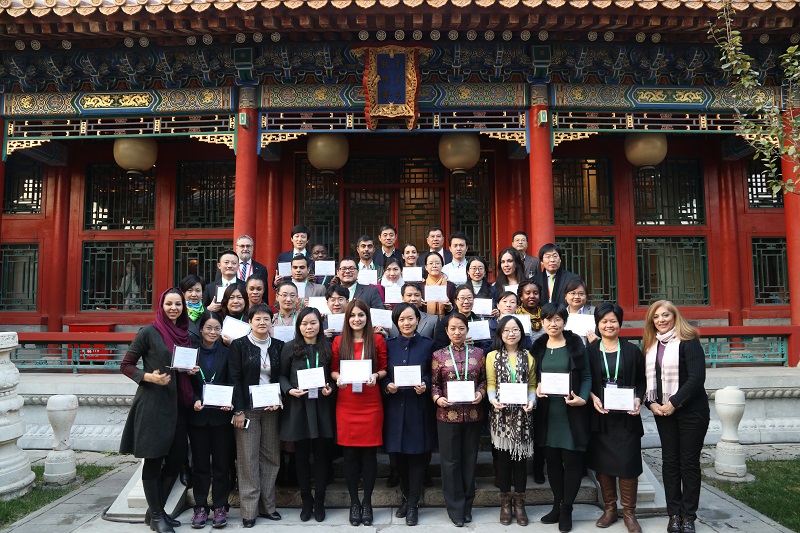
Having finished with the lectures and workshops, each day we went sightseeing and got acquainted with the local culture. Beijing is a huge city with lots of attractive sights when it comes to heritage – from the famous Temple of Heaven, to the Diplomatic district, to Lake Shichahai. We also had the opportunity visit local restaurants where we tasted traditional dishes and drinks, which, frankly, the majority of us were not too keen on.
每天的培訓結(jié)束之后,我們都會去體驗北京當?shù)氐奈幕1本┦且粋€擁有許多文化遺產(chǎn)地和風景名勝的大都市——我們游覽了著名的天壇、使館區(qū)(編者注:應為東交民巷使館建筑群),還有什剎海;還去到當?shù)氐牟蛷d,品嘗了北京的傳統(tǒng)菜肴和飲品。不過坦白說,我們大多數(shù)人對這些食物都不太喜歡。
The Secrets of the Forbidden City
故宮的秘密
The organizers went out of their way to make our stay in their country memorable. The visit to the main sites in China was organized by the ICOM International Training Centre.
培訓的組織者為了能讓我們擁有一次難忘的北京之行頗費心思。在他們的安排下,我們參觀了很多中國著名的文化遺產(chǎn)地。
We were in for the biggest surprise yet on the last day of our stay. As museum experts, we had the pleasure to see the areas of the Palace Museum not open to the majority of visitors, which our Chinese colleagues were kind enough to show us. Entering the perfectly restored and conserved parts of the Forbidden City several hundreds of years old, we were able to learn about the less visible part of the Chinese history with the help of expert guides.
最后一天,我們收獲了本次培訓最大的驚喜。作為博物館同仁,我們非常有幸地被邀請參觀了工作人員精選的故宮博物院展區(qū),我們的中國同行真是慷慨之極!在專業(yè)講解員的帶領(lǐng)下,我們踏入了擁有百年歷史的紫禁城,了解到許多中國歷史中鮮為人知的故事。
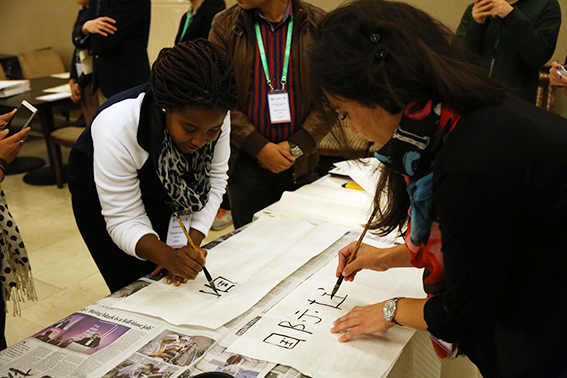
The trip to China and participation in the training workshop Collecting Objects, Telling Stories was an extraordinary professional experience. By exchanging knowledge and gaining new one in the country with a different museum tradition, not only did individuals from all over the world profit professionally, but also the institutions in which we work, as well as the relevant associations the members of which we are. Further cooperation with the Chinese colleagues who are very interested in the exchange of experience with their Serbian peers might be one of the priorities of our country’s cultural strategy in future.
在中國參加“藏品與故事講述”培訓是一次絕妙的專業(yè)培訓經(jīng)歷。在一個有著不同博物館傳統(tǒng)的國家交流和學習新知識,不僅讓來自世界各地的學員個人受益匪淺,對我們各自工作的機構(gòu),以及我們所在的相關(guān)協(xié)會同樣意義深遠。有些中國同行對中塞交流很感興趣,與他們進一步合作也極可能成為我國未來文化發(fā)展戰(zhàn)略的一個重要方向。
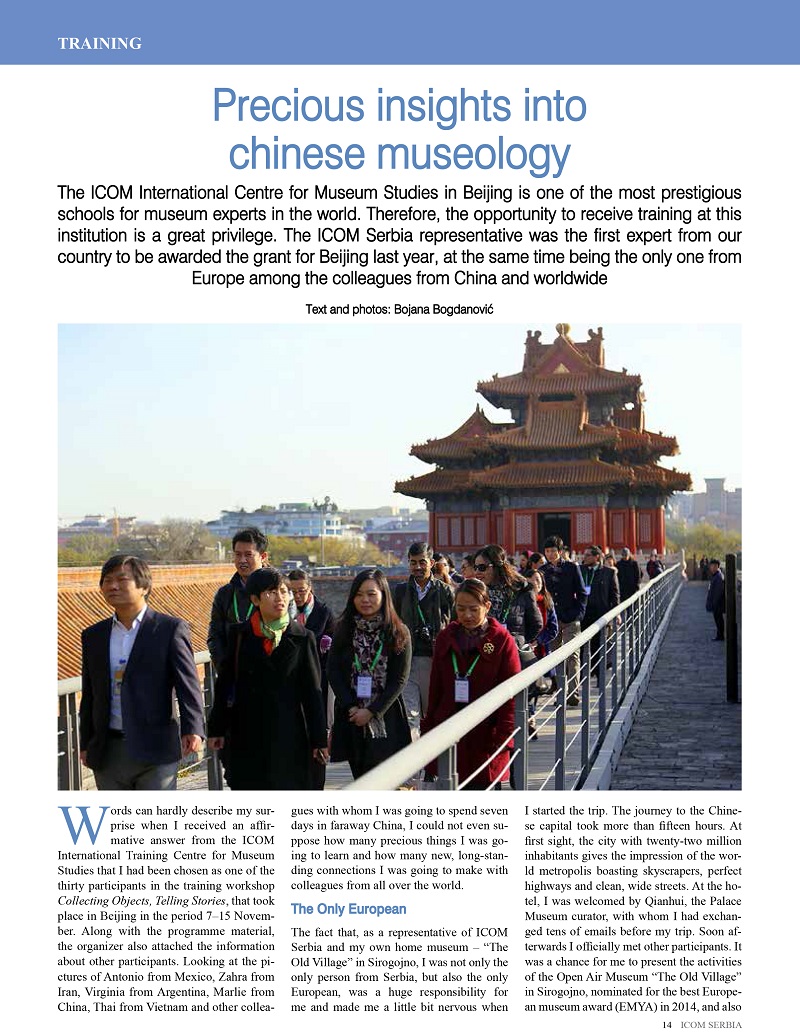
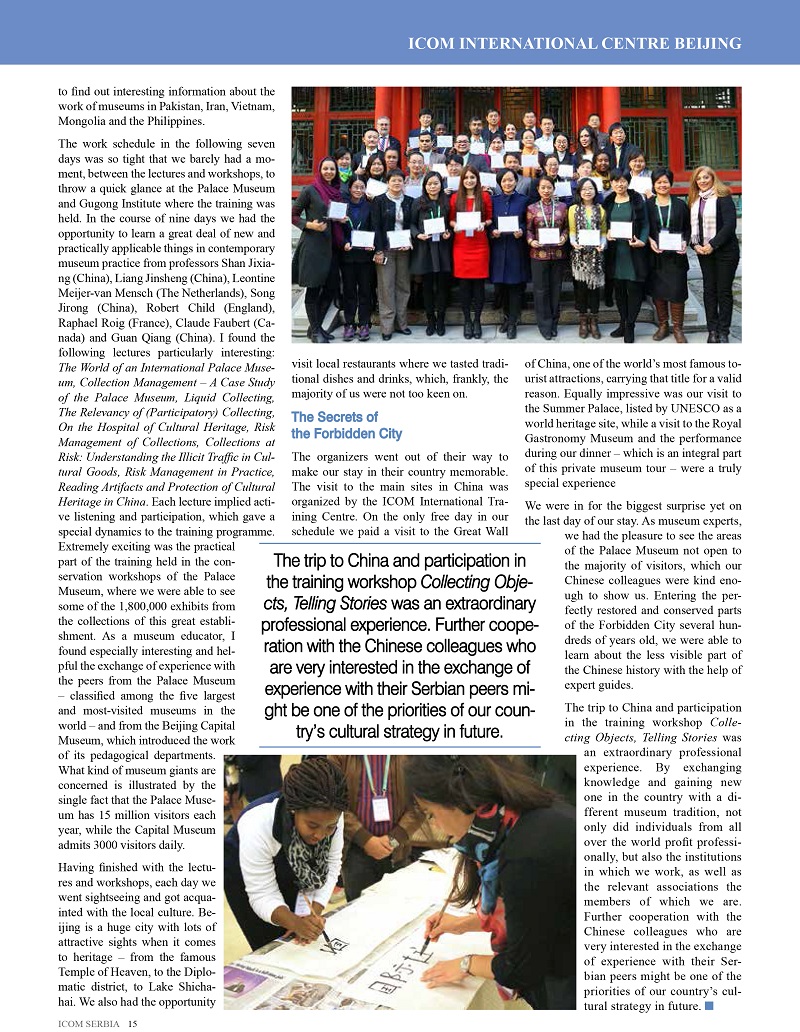
ICOM-ITC定于2017年11月舉辦第九期常規(guī)培訓班,即2017年秋季培訓班。本期培訓班的主題為“博物館參與型展覽開發(fā)”,培訓將圍繞博物館品牌化、展覽設(shè)計與開發(fā)、隨展項目開發(fā)、展覽評估等專題進一步展開。
每期培訓班最多招收學員35名,其中中國學員15-18名。現(xiàn)中國學員招生報名正在火熱進行中。



 圖書館
圖書館
 視聽館
視聽館
 故宮旗艦店
故宮旗艦店
 全景故宮
全景故宮
 v故宮
v故宮

